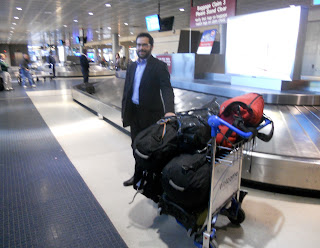The territory encompassed by the modern nation of Jordan has been inhabited by humans for about 250,000 years, including the civilizations of the Egyptians, Assyrians, Babylonians, Greeks, Romans, Nabataeans and Ottoman Turks. The area of the capital, Amman, has been settled since around 8500 BC. The first week we were here we took a field trip down from the hotel to the Citadel, an ancient fortress site, and ate falafel and shwarma on some relatively recent Roman ruins (built around 170 AD). [edit: see pics below!] The site of the oldest church in the world, dating from around 33 AD, is at Rihab 40km south of Amman.
The country’s western border is the Jordan River, which flows from the mountains in Lebanon and Syria to the north down to the Red Sea. Iraq and Saudi Arabia are to the east. Across the river is the West Bank and Israel. Overlooking the Jordan Valley south of Amman is Mount Nebo, in the biblical land of Moab, where Moses showed the promised land of Canaan to the Israelites. We’ll take some pictures of the view and post them when we get to visit later on.
Obviously there’s a little too much history here for one blog post. More recently, during World War I, Faisal, the ruler of Mecca, and his brother Abdullah led Arab fighters in revolt against the Ottoman Empire, which was fighting alongside Germany against the Allies. TE Lawrence (“of Arabia”) helped the Arabs in a campaign that ended with Arab control of the area that is now Jordan, the Arabian Peninsula and southern Syria.
At the Paris Peace Conference in 1919 the Allies gave the territory of Iraq to Faisal and the area from Iraq west to the Jordan River to Abdullah. Abdullah made Amman the capital of the new state of Trans-Jordan, which became fully independent from Britain in 1946, with Abdullah ruling as king.
In the aftermath of the creation of the state of Israel in 1948, King Abdullah gained control of East Jerusalem and the West Bank. The king proclaimed a new state within the enlarged territory, the Hashemite Kingdom of Jordan.
King Abdullah was assassinated in Jerusalem in 1951, and his 17-year-old grandson, Hussein, became king. After the Six Day War, in 1967, Jordan lost control of the West Bank and East Jerusalem. Over the next 25 years, King Hussein became known for skillful diplomacy, moderation and successful governance of the young nation, culminating in a peace treaty with Israel in 1994. After Hussein’s death in 1999, his son Abdullah took the throne. King Abdullah II’s commitment to continuing his father’s work in developing Jordan into a thriving modern state includes partnering with the Peace Corps in projects to improve the lives of his people, which is where Anne and I come in. More about the specifics of that later.

















































